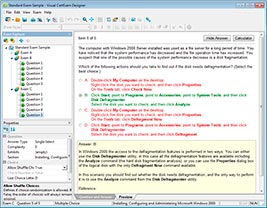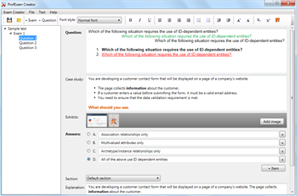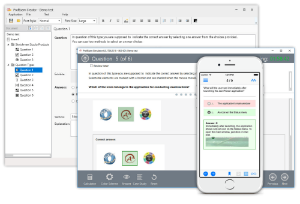Download SAP Certified Associate-Data Analyst-SAP Analytics Cloud.C_SAC_2501.VCEplus.2025-03-27.32q.vcex
| Vendor: | SAP |
| Exam Code: | C_SAC_2501 |
| Exam Name: | SAP Certified Associate-Data Analyst-SAP Analytics Cloud |
| Date: | Mar 27, 2025 |
| File Size: | 23 KB |
How to open VCEX files?
Files with VCEX extension can be opened by ProfExam Simulator.
Purchase
Coupon: TAURUSSIM_20OFF
Discount: 20%
Demo Questions
Question 1
You input new data for a private version in a story. What must you do to ensure the new data is added to the model?
- Save
- Send
- Publish
- Nothing
Correct answer: C
Explanation:
SAP Analytics Cloud Help Documentation: Private Versions and PublishingSAP Analytics Cloud User Guide: Working with Private Versions in StoriesWhen inputting new data for a private version in a story in SAP Analytics Cloud, it is necessary to 'Publish' the data to ensure it is added to the model. Publishing the private version commits the changes to the underlying model, making the new data visible and accessible to other users according to their permissions. This step is crucial for ensuring that the updated data is incorporated into the shared model for further analysis and decision-making. SAP Analytics Cloud Help Documentation: Private Versions and Publishing
SAP Analytics Cloud User Guide: Working with Private Versions in Stories
When inputting new data for a private version in a story in SAP Analytics Cloud, it is necessary to 'Publish' the data to ensure it is added to the model. Publishing the private version commits the changes to the underlying model, making the new data visible and accessible to other users according to their permissions. This step is crucial for ensuring that the updated data is incorporated into the shared model for further analysis and decision-making.
Question 2
What account types use the average rate type? Note: There are 2 correct answers to this question.
- INC
- AST
- EXP
- LEQ
Correct answer: AC
Question 3
You are creating a data action to copy data from one year to the next.In the parameter for the source year, which default setting must you change?
- Level
- Hierarchy
- Cardinality
- Granularity
Correct answer: C
Question 4
You want to total several income and expense accounts using the account type property.
What configuration option in the advanced formula must you use?
- Unbooked
- Append
- Signflip
- Aggregate To
Correct answer: C
Question 5
You have a dimension with members for product groups and products. Each product group has associated products.
You want to plan by product group without disaggregating into the products. How can you do this?
- Use two properties
- Dis-able allocations
- Use two hierarchies
- Dis-able distribution
Correct answer: C
Explanation:
SAP Analytics Cloud Help Documentation: Hierarchies in PlanningSAP Analytics Cloud User Guide: Managing Hierarchies for PlanningWhen you have a dimension with members for product groups and associated products and want to plan by product group without disaggregating into the individual products, using two hierarchies is the best approach. One hierarchy can represent the product groups at a higher level, allowing for planning and analysis at the group level. The second hierarchy can include both the product groups and their associated individual products for more detailed analysis when needed. This approach provides flexibility in planning and analyzing data at different levels of detail without the necessity of disaggregating data at the product group level. SAP Analytics Cloud Help Documentation: Hierarchies in Planning
SAP Analytics Cloud User Guide: Managing Hierarchies for Planning
When you have a dimension with members for product groups and associated products and want to plan by product group without disaggregating into the individual products, using two hierarchies is the best approach. One hierarchy can represent the product groups at a higher level, allowing for planning and analysis at the group level. The second hierarchy can include both the product groups and their associated individual products for more detailed analysis when needed. This approach provides flexibility in planning and analyzing data at different levels of detail without the necessity of disaggregating data at the product group level.
Question 6
What can you do with a multi action? Note: There are 2 correct answers to this question.
- Run allocation data actions
- Import transaction data
- Approve data
- Run allocation processes
Correct answer: AB
Question 7
You are creating an allocation step to distribute expenses from the HR cost center to your operating cost centers.
Which dimension setting controls how much is distributed to each operating cost center?
- Reference
- Driver
- Distribute
- Redistribute
Correct answer: B
Explanation:
SAP Analytics Cloud Help Documentation: Allocation Steps in PlanningSAP Analytics Cloud User Guide: Using Drivers for AllocationIn the context of creating an allocation step to distribute expenses from the HR cost center to operating cost centers in SAP Analytics Cloud, the 'Driver' dimension setting is crucial. This setting determines the basis or criteria on which the distribution is calculated and applied to each operating cost center. For instance, the driver could be the number of employees, square footage, or any other relevant metric that justifies the distribution of costs.By defining a driver, you ensure that the allocation of expenses is proportional and fair based on the selected criteria. SAP Analytics Cloud Help Documentation: Allocation Steps in Planning
SAP Analytics Cloud User Guide: Using Drivers for Allocation
In the context of creating an allocation step to distribute expenses from the HR cost center to operating cost centers in SAP Analytics Cloud, the 'Driver' dimension setting is crucial. This setting determines the basis or criteria on which the distribution is calculated and applied to each operating cost center. For instance, the driver could be the number of employees, square footage, or any other relevant metric that justifies the distribution of costs.
By defining a driver, you ensure that the allocation of expenses is proportional and fair based on the selected criteria.
Question 8
You are entering values for several expense accounts in a data table.
Which data entry mode must you use to process the data with a delay defined in System Administration?
- Fluid
- Single
- Mass
Correct answer: A
Question 9
Where can you change a data lock status? Note: There are 2 correct answers to this question.
- Data action
- Value lock management
- Multi action
- Calendar task
Correct answer: CD
Question 10
How can you improve the performance of advanced data actions? Note: There are 3 correct answers to this question.
- Use fewer MEMBERSET statements
- Use fewer FOREACH functions
- Use fewer IF statements
- Use fewer data functions
- Use fewer aggregation dimension functions
Correct answer: BCD
Question 11
What type of predictive scenario can write back to a planning model?
- Regression
- Value driver tree
- Classification
- Time series forecast
Correct answer: D
Explanation:
SAP Analytics Cloud Help Documentation: Predictive Scenarios and PlanningSAP Analytics Cloud User Guide: Time Series Forecasting in Planning ModelsIn SAP Analytics Cloud, a Time Series Forecast predictive scenario can write back to a planning model. Time Series Forecasting leverages historical data to predict future values over a specified time horizon, using statistical or machine learning methods. This feature is particularly useful in planning and forecasting processes, where future values are predicted based on past trends and seasonality. The ability to write these forecasts back into a planning model allows for the integration of predictive insights into the planning process, enhancing decision-making and strategic planning. SAP Analytics Cloud Help Documentation: Predictive Scenarios and Planning
SAP Analytics Cloud User Guide: Time Series Forecasting in Planning Models
In SAP Analytics Cloud, a Time Series Forecast predictive scenario can write back to a planning model. Time Series Forecasting leverages historical data to predict future values over a specified time horizon, using statistical or machine learning methods. This feature is particularly useful in planning and forecasting processes, where future values are predicted based on past trends and seasonality. The ability to write these forecasts back into a planning model allows for the integration of predictive insights into the planning process, enhancing decision-making and strategic planning.
HOW TO OPEN VCE FILES
Use VCE Exam Simulator to open VCE files

HOW TO OPEN VCEX FILES
Use ProfExam Simulator to open VCEX files


ProfExam at a 20% markdown
You have the opportunity to purchase ProfExam at a 20% reduced price
Get Now!



